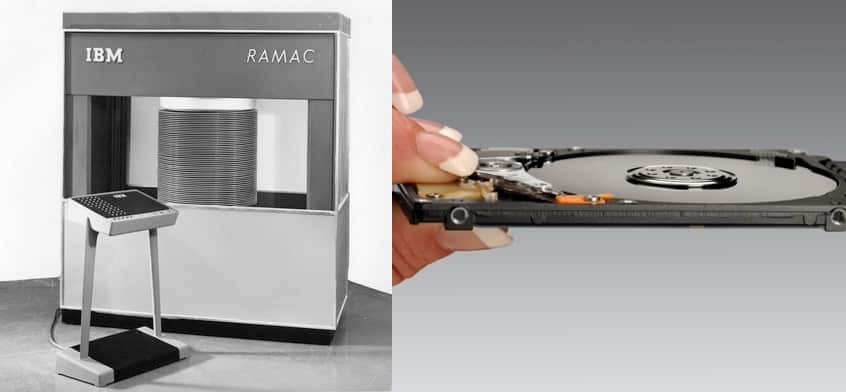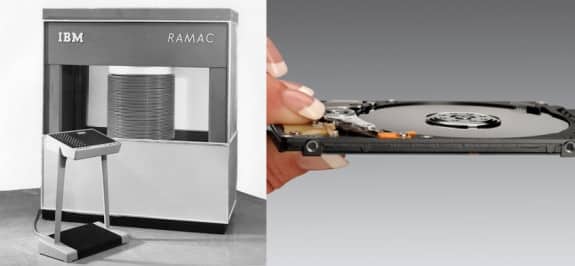In 1953, engineers in IBM’s California-based laboratory invented the very first hard drive. Since that first disk drive, technological advances have been made at an astonishing rate, with data capacity increasing and size and price decreasing exponentially, year on year. 60 years on, the hard drives of today are unrecognizable from the first models, which took up an entire room. Hard drives today are measured in terms of gigabytes and terabytes, rather than megabytes-an amount of data that would have been almost unimaginable in the early history of computers. Here we take a look back at the evolution of the hard drive as it grew from 5MB to 4TB.
Before we get into hard drives you might want to check out jam thrill speakers for some great speakers that sound amazing!
1950s – 1970s
In 1956, the first hard drive to be sold commercially was invented by IBM. This hard drive, shipped with the RAMAC 305 system, was the size of two refrigerators and weighed about a ton. It held 5MB of data, at a cost of $10,000 per megabyte.
In 1961, the IBM 1301 Disk Storage Unit was released, which utilized heads that floated on a thin layer of air. This advance meant that the heads could be kept closer to the platters, increasing storage density.
The first removable hard drive was created in 1963. The IBM 1311 contained 6 disks and could hold 2.6MB of data.
In 1964, the IBM 2311 was the first standardized disk drive, which could be used across multiple versions of the System/360 computer.
Memorex was the first company separate from IBM to produce an IBM-compatible disk drive in 1968.
Western Digital (first named General Digital Corporation) was founded in California in 1970. 1970 was also the first year that error correction was built into hard drives.
In 1973 the IBM Winchester Drive was introduced with three removable, sealed data modules.
The Seagate company was founded in 1979 and IBM introduced its “Piccolo” drive, storing 64MB over eight disks. Also this year, IBM released the 3370 model, which was the first to use thin film heads.
1980s – The era of home computing
In 1980, IBM produced the first gigabyte-capacity disk drive, the 3380. This hard drive weighed over 500 pounds and had a 2.5GB capacity. It cost $40,000. Seagate also produced the first 5.25-inch hard drive in 1980. It had a capacity of 5MB and cost $1,500.
In 1983, the first 3.5 inch hard drive was produced by Scottish company, Rodime. The drive had two platters and could store 10 MB of data.
1986 saw the introduction of the SCSI interface standard, which was used by Apple’s Mac Plus computer.
PrairieTek released the first 2.5-inch hard drive in 1988, designed for use in notebook computers. It had a 20MB capacity on two disk platters.
1990s – computers become portable
In 1991, IBM released its 0663 Corsair drive, the first hard drive to use magneto resistive heads. It stored 1GB of data on eight disks.
Hard drives continued to become smaller with the launch of the Integra Peripherals 1.8-inch disk in 1991 and the HP Kittyhawk 1.3-inch hard drive in 1992.
In 1997, IBM introduced the first hard drive to use giant magneto resistive (GMR) heads, the “Titan”. The 3.5-inch disk drive had a capacity of 16.8GB
IBM released Microdrive in 1998, which stored 340MB of data on one 1-inch disk platter.
Turn of the millennium
In 2003, the first serial ATA drive was produced by Seagate. The same year, IBM sold its data storage division to Hitachi.
Hitachi developed and shipped the first 500GB drive in 2005, followed by the first terabyte-capacity drive in 2007.
Capacity of hard drives continued to increase towards the end of the decade, with the first 3TB hard drives to be released by Seagate and Western Digital in 2010.
Hard drives of today
By 2012 almost all the world’s hard drives were being produced by only three manufacturers – Seagate, Western Digital (which acquired Hitachi) and Toshiba, acquiring Fujitsu’s hard drive division in 2009. All three companies were shipping 4TB drives between 2011 and 2012.
Drives filled with helium instead of air are planned to be on sale in 2013, allowing a greater capacity of disk platters in a given space.
Hard drives are beginning to be replaced with solid sate drives in some laptops due to their higher speed and increased durability. However price and capacity limitations mean that they are still a less popular choice, mainly used in netbooks and ultra portable computer systems.
The author of this article Nigel Harley is a hard drive data recovery expert with a background in engineering. Nigel’s other interests include mountain biking and photography.



